![[Hungarian flag]](../images/h/hu.gif)
image by Zoltan Horvath, 12 June 2024

Last modified: 2025-04-19 by zoltán horváth
Keywords: hungary | europe | budapest | cross of lorraine | oak leaves | bent cross | magyar |
Links: FOTW homepage |
search |
disclaimer and copyright |
write us |
mirrors
![[Hungarian flag]](../images/h/hu.gif)
image by Zoltan Horvath, 12 June 2024
Official Name: Hungary (Magyarország) (since 01 January 2012)
Capital: Budapest
Location: Central Europe
Government Type: Republic
Flag adopted: 1957
(First used 1848)
Coat of Arms adopted: 1990 (First used XII-XIII
C.)
ISO Code: HU
See also:
From the DK book: "The current flag was first used in the 1848-49 uprising. Its pattern was derived from the French Tricolore used during the French Revolution. The colors: red, white and green, date back to the 9th century. They were first used in 1608 during the reign of King Matthias II. Until 1945, the royal crown appeared in the center of the national flag."
Red - symbolizes strength
White - faithfulness
Green - hope
Phil Nelson, 21 November 1999
From page 623 of the Magyarország történeti kronológiája
II. 1526-1848. Akadémiai Kiadó, Budapest 1982 (Chronology
of the Hungarian History 2nd part 1526-1848) :
"1806. During the year: The official colours of the flag of
the Empire of Austria are the black and yellow, the official
colours of the flag of the Kingdom of Hungary are the red, white
and green."
István Molnár, 23 July 2000
This flag represented the Hungarian state within the Empire,
at least after the revolutionary 1848. It was this flag that was
so hated in Zagreb in late 19th century and not the Austrian one.
In any case, the lexicons of late 19th century (like Mayers) list
this flag.
Željko Heimer, 11 November 2000
I have seen a film on the m1 TV an hour ago about the
Hungarian historical flags. Some informations:
The tricolour was used first in 1801 by Joseph, Palatine of
Hungary
The tricolour is used from 1830s. The ratio 2:1 Maybe this is the
official version?!
The national flag has to be used on the official buildings - for
example: schools, city halls, hospitals, police Stations - from
20 August 2000.
Istvan Molnar, 28 November 2000
The official flag is the tricolour without coat of arms. The
ratio of the official flag is 1:2. The tricolour in 2:1, 3:2 and
2:3 is used also. The tricolour with coat of arms can be used
too. This flag was in use in 1848 - 1849, 1867 - 1919, 1919 -
1949 and 1956 - now.
In 1849-1867, Hungary was under Austrian occupation and the
country was divided.
In 21 March1919 - 31 July 1919, the Hungarian Soviet Republic
used the red flag.
In 1949-1956, on the flag there was the Rákosi coat of arms.
István Molnár, 25 June 2001
Istvan Molnar reported the Government decree about the
national flag of Hungary. It should have 1:2 ratio. Does it mean
that Hungary has changed its flag in 2000?
All previous reports spoke about 2:3 ratio.
Jan Zrzavy, 13 Auguat 2001
No! All previous reports and datas were WRONG!
The official Hungarian flag is the red-white-green tricolour
without coat of arms - ratio 1:2 - from 1848! (means: 1848-1849,
1867-1919, 1919-1949, 1957-now!). You can see many variations of
ratios 2:3, 3:5, 1:3, 3:2 etc....
See below the Legislation about the national
flag.
Istvan Molnar, 13 Auguat 2001
According to Album 2000 [pay00]
- National Flag (CS-/CS- 2:3) - RWV flag. If I am not much
mistaken, the proper ratio for the national flag is 1:2, at least
on land. At sea 2:3 is used.
Željko Heimer, 2 November 2001
Currently, the Constitution of Hungary does not state anything about the
width:length ratio of the flag. It states only that three stripes have equal
width. I suppose that the new constitution will follow this tradition. However,
there is a law from 1957 (about navigation on sea and inland waters), which
appears to be valid. It states that sea-going merchant vessels shall hoist the
red-white-green tricolour in 2:3 ratio. Before 2000, it was the reference for
all flags and ensigns. A new law has been adopted in 1995 (modified in 2000)
about usage of flags and ensigns, but the ratio has not been mentioned by them.
Because ratio is neither defined in the Constitution, nor the 1995 or 2000 law,
the government decree no. 132/2000 regulates sizes of flag and even flagpoles,
the ratio of flags used on government building is 1:2.
Flag size Flagpole
100x200 cm 2,5 m
150x300 cm 3,5 m
200x400 cm 4 m
100x200 cm 6 m
150x300 cm 9 m
200x400 cm 12 m
Summarized this would mean:
Civil flag: A red-white-green tricolour. Actually many variations might be used
though according to 1995/LXXXIII § 11 (3) "
In cases specified in paragraphs (1) and (2), the arms and the flag can be used
also in their historical forms.", as (1) reads as: 1995/LXXXIII
§11 (1) "(1) For the purpose of declaring
the pertainance to the nation, private citizens can use the flag, keeping the
limitations contained in this law." It means that both ratio 2:3 and 1:2 are
allowed.
National and state flag: red-white-green tricolour, ratio 1:2 (by decree No.
132/2000). According to 1995/LXXXIII 11 §.
(4), the official coat of arms of Hungary might be placed onto it as a badge.
But coat of arms might be used only by authorized persons and offices, defined
the same law.
War flag: White background with green red alternated flammulette ("flame
tongues", triangles with wavy edge) border, coat of arms in the center, embraced
by oak-branches from the left, olive branches from the right. Ratio is defined
by decree of Minister of Defense No. 3/1996: Its size shall be 120 cm x 140 cm.
Civil ensign: 2:3 (ratio defined by 1957 navigation law) red-white-green
tricolour (there is a merchant fleet).
State ensign: Unspecified. Hungary is landlocked, there is no state vessel.
Police vessels use the civil ensign.
War ensign: White background with green-red alternated triangle border, coat of
arms at 1/3 of the flag, nearer to the flagpole. (1995/LXXXIII 8 sect;
(2)) Ratio is defined by decree of Minister of Defense No. 3/1996.
These are all information at this time about usage and ratios of various
Hungarian flags.
Zoltan Horvath, 14 January 2011
The Hungarian Flag Standard (MSZ 1361:2009) defines the colors of Hungarian flag in CIELAB and Pantone colors as Pantone 18-1660 TCX for red and 18-6320 TCX for green:
But these Pantone values are valid for textile printing only.
Approximate color values in CMYK and
'normal' Pantone system are (pg. 3):
Red: CMYK 0-100-100-0, Pantone 485
Green: CMYK 87-35-76-25, Pantone 555
Zoltan Horvath, 12 June 2024
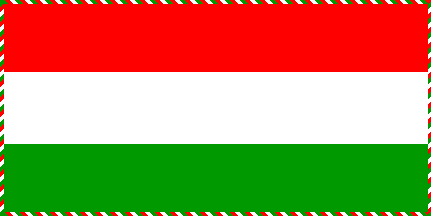
image by Antonio Martins , 19 May 1997
Along with the normal state flag (civil but with coat of
arms), I saw in various public buildings a 2:1 red-white-green
flag with no charges and a distinct fringe of those colors. Any
info?
Antonio Martins, 9 May 1997
Fringed flags are quite often in Hungary, as I have noticed -
either with coat of arms or without it, even the flags hoisted
outside. But, maybe, there is some significanse, since two flags
were hoisted?
Željko Heimer, 10 May 1997
Off the top of my head, I'd say it's a variation on the civil
flag. My scouts' regiment regimental flags all are
'national fringed'.
Georges Kovari III, 19 June 1999
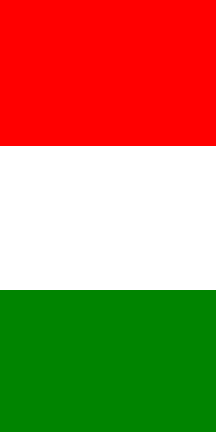
image by István Molnár, 8 May 2001
Yesterday I have seen this short Hungarian flag in Sárvár.
It is a flying flag, not hanging one!
István Molnár, 8 May 2001
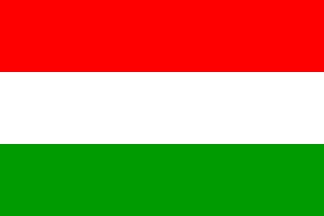
image by Antonio Martins, 24 April 1999
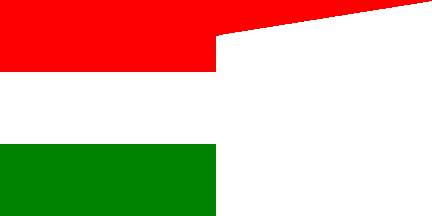
image by Istvan Molnar, 15 August 2001
Today was the Millennium ceremony in Esztergom and I have seen
this flag flying on the walls beside the Millennium Statue.
István Molnár, 15 August 2001
This flag is flying below the Millennium Statue of the county.
Maybe it will be a new tradition. Historical form with the
tricolour.
István Molnár, 26 August 2001
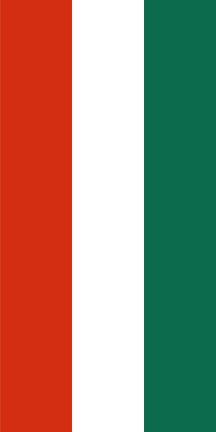
image by Zoltan Horvath, 12 June 2024
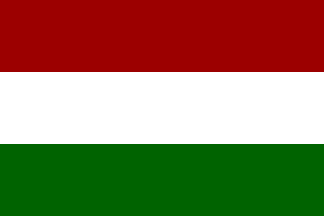
image by Mladen Mijatov and Tomislav Todorović,
27 November 2007
The national flag of Hungary with dark shades of red and green
colours was shown on the photo from a presentation of the Hungarian Justice and Life Party, which
was published in Serbian magazine "Evropa" (ISSN
1820-0761), issue #45 of 2005-02-17, p. 28; at the right-hand
side of the photo, several such flags were hung on the wall. At
the party web site, such flags might
have been seen on different photos. The same is also true for
numerous photos at the site of Sixty-four
Counties Youth Movement. It seems that such flags are often
used by extreme right-wing organizations, although the reason for
use of such dark shades of colours is not widely known yet.
Tomislav Todorović, 27 November 2007
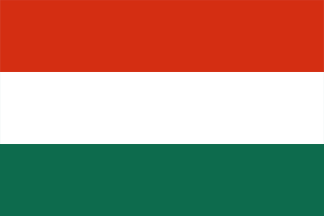
image by Zoltan Horvath, 12 June 2024
According to Res. No. 51/1957 (VIII.18.)/ at <www.kff.hu>,
the Hungarian flag for use at sea is red-white-green. Ratio 2:3
István Molnár, 4 April 2001
On the page of
the Shipping Authority there was only one law concerning
flags: It is a statute regulation as old as from 18th August
1957, but it still seems to be valid.
In 1§ it prescribes that Hungarian sea-going (!) merchant
vessels shall (1) hoist the r-w-g tricolour in (2) ratio 2:3 and
that they (3) may not use "mast ribbons" (whatever is
meant by that).
2§ states that by this decree the old one from 1950 loses its
validity.
Marco Pribilla, 1 November 2001
I guess that (3) refers to what we call "masthead
pennant" or "war pennant". It seems logical that
merchant vessels are prohibited these since they as a rule
declare a vessel to be a warship (c.f. the other name
"commission pennant").
Željko Heimer, 2 November 2001
Hungary had got mercantile fleet after treaty of Trianon and
had got a "River Navy".
More information at <www.mahart.hu>,
<www.papernet.hu>,
<www.mateinfo.hu>.
List of Hungarian ships and shipping line at <www.papernet.hu>.
István Molnár,
Here is legislation that describes the use of the civil ensign.
Zoltan Horvath, 12 June 2024
The protocol manual for the
London 2012 Olympics (Flags and Anthems Manual
London 2012 [loc12]) provides recommendations
for national flag designs. Each
NOC was sent an image of the flag,
including the PMS shades, for their approval by LOCOG. Once this was obtained, LOCOG produced
a 60 x 90 cm version of the flag for further approval. So, while these specs may
not be the official, government, version of each flag, they are certainly what
the NOC believed the flag to be.
For Hungary: PMS 186 red, 348 green. The vertical flag is simply the horizontal
version turned 90 degrees anti-clockwise.
Ian Sumner, 10 October 2012
Law LXXXIII of 1995 about the use of the national symbols of
the Hungarian Republic and the use of names that make reference
to the Hungarian Republic
11. § (1) For the purpose of declaring the pertainance to the
nation, private persons can use the arms and the flag, keeping
the limitations contained in this law.
(2) The use of the arms and the flag is permitted - keeping the
limitations contained in this law in case of: national
holidays, programs in relation with national holidays and other
kind of programs (political, economical, scientific, etc.),
commemorations of national character, and also casual use for
giving military honors.
(3) In cases specified in paragraphs (1) and (2), the arms and
the flag can be used also in their historical forms.
(4) The use of the arms on the flag is permitted in all cases -
and with the same conditions -, when the use of the arms is
permitted by the law.
Ivan Marinov, 11 January 2001
Constitution of Hungary - paragraph 76 (at <www.parlament.hu>):
The flag of Hungary is red-white-green.
Law LXXXIII. /1995/ about the symbols of Hungary at <www.complex.hu/T9500083.HTM>
Law XXXVIII. /2000/ at <www.complex.hu/kzldat/T0000038.HTM>.
Istvan Molnar, 23 March 2001
No. 132/2000. (VII.14.) order of the Government about the
national flag (at <www.konfoderaciok.hu>):
Ratio of the flag: 1:2 . On the Appendix you can find measures of
flags and flag-poles sizes (on the end of the page).
István Molnár, 23 March 2001
The first law about the flag was the Law XXI in 1848. It said:
"1. The national colour and the Coat of Arms of the country
restituted to traditional law" [No data of ratio. The
official used flag was the 1:2 flag. The laws later renewed it!]
In the Constitution (XXth Law in 1949 modified by the XL Law in
1990) at <www.mkogy.hu>:
"76. § The flag of the Republic of Hungary contains three
equal horizontal red, white and green stripes. [No data of ratio.
It was traditionally 1:2]
Law LXXXIII (1995) about the using of the national symbols says
nothing about the ratio too.
Resolution No. 132/2000 (VII. 14.) of the Government is defined
the dimension of the flag - NOT modified, only determined.
The official dimensions are:
1. 100x200 cm 2,5 m (flagstaff)
2. 150x300 cm 3,5 m
3. 200x400 cm 4 m
You can find the Resolution No. 51/1957 (VIII. 18) of the
Government from 1957 which defined the flag using on the sea (its
ratio was 2:3!) at <www.kff.hu>.
Istvan Molnar, 13 Auguat 2001
I managed to find a Hungarian government decree (132/2000,
issued 14.7.2000) complementary to the 2000 flag law. In the
appendix the exact sizes of the flags to be used at government
buildings are prescribed according to mast length and the flags
are indeed all in ratio 1:2. (The decree even states that the
flag is to be cleaned at least every three months and replaced by
a new one once a year!)
On the other hand, there is the decree of 1957 <www.kff.hu>
which prescribes the 2:3 tricolour for merchant vessels. The
constitution and the flag laws of 1995 and 2000 say nothing about
the ratio.
So according to this information it seems that BOTH 1:2 and 2:3
are official, but for different use. The 2:3 tricolour is the
merchant ensign, and 1:2 is some kind of state flag on land. For
the ratio of private flags used on land, however, I have not
found any prescriptions, so I guess anything goes...
Marco Pribilla, 18 November 2001
It was very interesting for me to see that in Hungary, flags on
half mast as a symbol of mourn are NOT USED AT ALL. Last Sunday
was officially declared as a national mourning day due to a bus
accident in Styria, Austria. All buildings hoisted black flags,
and there was none national flag, full mast or half mast, at all.
What kind of tradition (or lack of it) may it be that, instead of
half mast national flags, solely black flags are hoisted as a
sign of mourning
David N. Biacsi, 4 Februar 1999
I read in one of my books (either Sisa's Spirit of Hungary
or Marek's The Eagles Die) that when Empress Elizabeth
was assassinated in Lucerne on Sept. 9 1898, black flags were
flown all over Budapest. As to whether they were also flown
throughout Hungary, I don't know, but I wouldn't doubt it.
Georges Kovari III, 4 Februar 1999
I am speculating here, but if the tradition (or lack of it, as
you put it) is anything similar to Croatia, and I believe it is
then an explanation similar to this could be given. Most of the
flags that are hoisted on private houses and blocks are of a kind
where the staff is obliquly attached to the house, and the flag
is attached to the sfatt either by the way of a sleve or nails.
Any of the two would make it totally unpractical to put the flag
on half-staff - it would require either resewing or getting the
nails out. In any case, as these staff would be of, say, 2 meters
long, a half-masted 1 meter wide flag would not look very well on
it anyway. It is therefore, that the solution of blackflag is
used.This is how I explain this around here, and maybe it would
be similar in Hungary.
Željko Heimer, 5 Febuary 1999
The colour of mourning has always been black in Hungary. It is
a tradition that has been in existence for centuries. They say
its roots have not been traced yet. So on the occasion of the
death of Queen Elizabeth in the last century it was flown because
it had been flown on such occasions ever since people could
remember not because it suddenly came to somebody's mind.
Albert Lugosi, 7 June 2000
When I was in Budapest last year, a black flag was hoisted on
the building of the Academy of Sciences after the death of a
famous scientist.
Ivan Sache, 15 September 2001
In Budapest, it is customary to fly black flags upon the death
of an important person. Last year, when a parliamentarian had
died in his nineties, the Parliament building - probably the most
attractive in the world - flew black flags alongside the
Hungarian national flag, on smallish flag poles at an oblique
angle from the building. This manner of flagpole is also
customary in Hungary on public buildings, in addition to a
vertical flagpole.
Colin Dobson, 23 June 2004